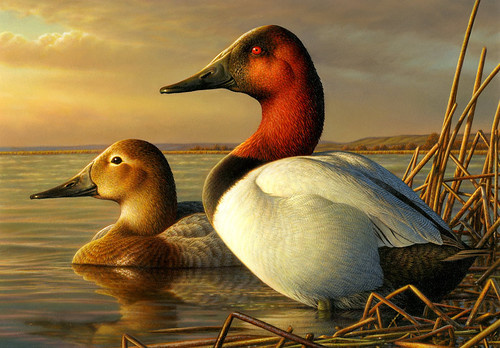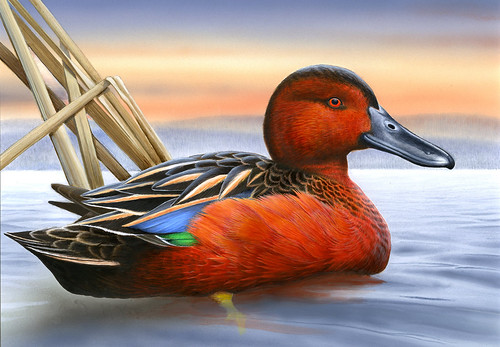Adam Grimm, an Ohio native who now lives in Burbank, S.D., is the winner of the 2013 Federal Duck Stamp Art Contest. The announcement was made today by U.S. Fish and Wildlife Service Deputy Director Rowan Gould at the Maumee Bay State Park and Conference Center in Oregon, Ohio, during the annual art contest – the only juried art competition sponsored by the federal government.

This is Grimm’s second Federal Duck Stamp Contest win. His art previously appeared on the 2000-2001 Federal Duck Stamp.
Grimm’s oil painting of a canvasback will be made into the 2014-2015 Federal Duck Stamp, which will go on sale in late June 2014. The Service produces the Federal Duck Stamp, which sells for $15 and raises about $25 million each year to provide critical funds to conserve and protect wetland habitats in the National Wildlife Refuge System for the benefit of wildlife and the enjoyment of people.
Hoyt Smith, of Tulsa, Okla., placed second with acrylic painting of a single cinnamon teal.

Ron Louque, of Charlottesville, Va., took third place with his acrylic painting of a trio of canvasbacks.

Louque previously won the Federal Duck Stamp Contest. His art previously appeared on the 2003-2004 Federal Duck Stamp.
Of 202 entries in this year’s two-day competition, 16 entries made it through to the final round of judging. Eligible species for this year’s Federal Duck Stamp Contest were the blue-winged teal, canvasback, cinnamon teal, gadwall and mallard.
“I congratulate Adam on his Federal Duck Stamp Contest win, and I look forward to seeing this beautiful artwork adorning the 81st Federal Duck Stamp,” said Gould. “I appreciate all the artists who entered this year and everyone else who supports the Federal Duck Stamp – one of our nation’s most enduring and successful conservation programs.”
“For eight decades, hunters, birders and millions of other people who purchase Federal Duck Stamps have made a direct contribution to wildlife conservation through the protection of wetland habitats,” said Jerome Ford, the Service’s Assistant Director for Migratory Birds. “Our nation’s birds and other wildlife – and people, too – thank everyone who ‘puts their stamp on conservation’ by buying Duck Stamps.”
The judges for this year’s Federal Duck Stamp Contest were: Douglas Brinkley, a best-selling author of books about U.S. conservation history; John Cornely, a retired Fish and Wildlife Service waterfowl biologist and manager; Mamie Parker, a retired Fish and Wildlife Service regional director; John Ruthven, an Ohio native and wildlife artist whose work appeared on the 1960-61 Federal Duck Stamp; and Charles “Chad” Snee, a philatelist and the associate editor of Linn’s Stamp News. The alternate judge was Gloria Erickson, an outdoorswoman, conservationist and rancher from Nebraska.
Waterfowl hunters age 16 and older are required to purchase and carry the current Migratory Bird Conservation and Hunting Stamp – commonly known as the Duck Stamp. Conservationists, stamp collectors and others may also purchase the stamp in support of habitat conservation. A current Duck Stamp can also be used for free admission to any national wildlife refuge open to the public.
Ninety-eight percent of the proceeds from sale of the $15 Federal Duck Stamp go to the Migratory Bird Conservation Fund, which supports the purchase of migratory bird habitat for inclusion into the National Wildlife Refuge System. You can buy Federal Duck Stamps at many national wildlife refuges, the U.S. Postal Service or online at www.fws.gov/duckstamps/stamps.htm.
Electronic files of the artwork can be downloaded from www.fws.gov/duckstamps
The mission of the U.S. Fish and Wildlife Service is working with others to conserve, protect, and enhance fish, wildlife, plants, and their habitats for the continuing benefit of the American people. We are both a leader and trusted partner in fish and wildlife conservation, known for our scientific excellence, stewardship of lands and natural resources, dedicated professionals, and commitment to public service. For more information on our work and the people who make it happen, visit www.fws.gov
.
Connect with our Facebook page at www.facebook.com/usfws, follow our tweets at twitter.com/usfwshq, watch our YouTube Channel at www.youtube.com/usfws and download photos from our Flickr page at www.flickr.com/photos/usfwshq/
Source: Press Release 09/28/2013, U.S. Fish and Wildlife Service





